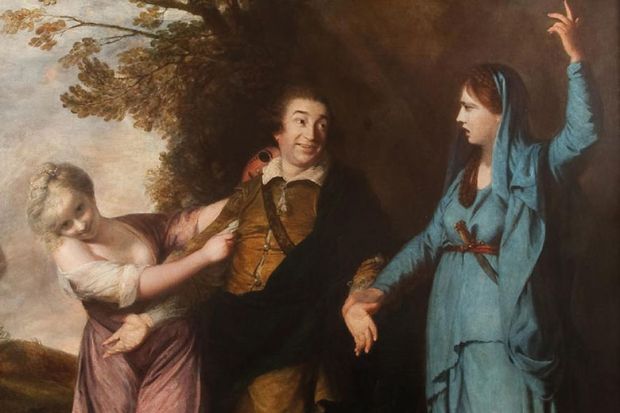David Garrick (1717-79) was a star actor, a theatre manager, a writer and, Leslie Ritchie argues, a media mogul. During the period 1747-76, when Garrick ran the Drury Lane Theatre, he was also performing and adapting Shakespeare as well as writing puffs, advertisements, poetry, prologues, epilogues and plays. Understanding that there is no such thing as bad publicity, he also stirred up discussion in the coffee houses of Georgian London by publishing anonymous attacks on his own work. He achieved astonishing market penetration and was almost always, in today’s terms, trending.
Ritchie claims that Garrick was possibly the first “modern” celebrity and, anachronistically but memorably, uses marketing concepts to explore Garrick’s media-savvy strategies, such as his skill in building and managing his “brand”. This “brand” sold him as a “natural” performer who could play wildly divergent roles, sometimes comedy and tragedy on the same night; a performer who, at a time when heroic leads were expected to be six-feet tall, played heroes despite his relatively short (but allegedly perfectly proportioned) stature; and who marketed the Drury Lane Theatre as the home of another successful brand, “Shakespeare”.
The book assumes knowledge of Garrick’s biography as Ritchie homes in on the details of his media strategies, documenting his shareholdings and proprietorial interests in a range of newspapers, and indicating how he could promote some news while suppressing publicity that could potentially favour rivals. He had long-standing connection with the Public Advertiser – Ritchie finds Garrick’s name in this newspaper more than 300 times in 1756 – but his writing appeared in a host of journals, newspapers and periodicals, with content sometimes reused, reworked and recycled many times.
While making a convincing case for Garrick’s attention to marketing, merchandising, liaising with booksellers and distributing portraits, Ritchie is overzealous in relentlessly signposting the direction of her argument and hammering some of her points home. And while its scrutiny of Garrick’s media influence and the “cobweb politics” involved makes the book an important resource, there could have been more on how Garrick’s mediation employed and influenced women, who are largely left on the margins of the “cobweb”.
Another neglected aspect is the degree to which some of Garrick’s “mediation” strategies were actually an extension of play-acting. The anonymous newspaper columns, poems and letters surely show him performing in print, playing a part offstage as well as on. Even in his final illness he was still working with an anonymous publishing persona, “Matthew Mum”, authoring “The Whisperer” column in the Public Advertiser – that is, he was assuming a voice, performing a role through writing. Yes, Garrick mediated celebrity skilfully, but he was also a showman, whether performing as Richard III, “The Whisperer” or friend to the Countess Spencer. And those performances were foundational in the mediation of his celebrity.
Liz Schafer is professor of drama and theatre studies at Royal Holloway, University of London. Her book Theatre & Christianity will be published by Red Globe Press this month
David Garrick and the Mediation of Celebrity
By Leslie Ritchie
Cambridge University Press, 320pp, £75.00
ISBN 9781108475877
Published 19 January 2019
Register to continue
Why register?
- Registration is free and only takes a moment
- Once registered, you can read 3 articles a month
- Sign up for our newsletter
Subscribe
Or subscribe for unlimited access to:
- Unlimited access to news, views, insights & reviews
- Digital editions
- Digital access to THE’s university and college rankings analysis
Already registered or a current subscriber?






